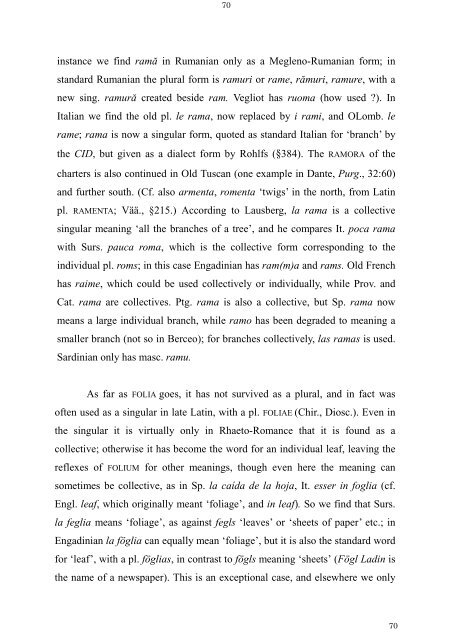The Latin Neuter Plurals in Romance - Page ON
The Latin Neuter Plurals in Romance - Page ON
The Latin Neuter Plurals in Romance - Page ON
You also want an ePaper? Increase the reach of your titles
YUMPU automatically turns print PDFs into web optimized ePapers that Google loves.
70<br />
<strong>in</strong>stance we f<strong>in</strong>d ramă <strong>in</strong> Rumanian only as a Megleno-Rumanian form; <strong>in</strong><br />
standard Rumanian the plural form is ramuri or rame, rămuri, ramure, with a<br />
new s<strong>in</strong>g. ramură created beside ram. Vegliot has ruoma (how used ?). In<br />
Italian we f<strong>in</strong>d the old pl. le rama, now replaced by i rami, and OLomb. le<br />
rame; rama is now a s<strong>in</strong>gular form, quoted as standard Italian for ‘branch’ by<br />
the CID, but given as a dialect form by Rohlfs (§384). <strong>The</strong> RAMORA of the<br />
charters is also cont<strong>in</strong>ued <strong>in</strong> Old Tuscan (one example <strong>in</strong> Dante, Purg., 32:60)<br />
and further south. (Cf. also armenta, romenta ‘twigs’ <strong>in</strong> the north, from <strong>Lat<strong>in</strong></strong><br />
pl. RAMENTA; Vää., §215.) Accord<strong>in</strong>g to Lausberg, la rama is a collective<br />
s<strong>in</strong>gular mean<strong>in</strong>g ‘all the branches of a tree’, and he compares It. poca rama<br />
with Surs. pauca roma, which is the collective form correspond<strong>in</strong>g to the<br />
<strong>in</strong>dividual pl. roms; <strong>in</strong> this case Engad<strong>in</strong>ian has ram(m)a and rams. Old French<br />
has raime, which could be used collectively or <strong>in</strong>dividually, while Prov. and<br />
Cat. rama are collectives. Ptg. rama is also a collective, but Sp. rama now<br />
means a large <strong>in</strong>dividual branch, while ramo has been degraded to mean<strong>in</strong>g a<br />
smaller branch (not so <strong>in</strong> Berceo); for branches collectively, las ramas is used.<br />
Sard<strong>in</strong>ian only has masc. ramu.<br />
As far as FOLIA goes, it has not survived as a plural, and <strong>in</strong> fact was<br />
often used as a s<strong>in</strong>gular <strong>in</strong> late <strong>Lat<strong>in</strong></strong>, with a pl. FOLIAE (Chir., Diosc.). Even <strong>in</strong><br />
the s<strong>in</strong>gular it is virtually only <strong>in</strong> Rhaeto-<strong>Romance</strong> that it is found as a<br />
collective; otherwise it has become the word for an <strong>in</strong>dividual leaf, leav<strong>in</strong>g the<br />
reflexes of FOLIUM for other mean<strong>in</strong>gs, though even here the mean<strong>in</strong>g can<br />
sometimes be collective, as <strong>in</strong> Sp. la caída de la hoja, It. esser <strong>in</strong> foglia (cf.<br />
Engl. leaf, which orig<strong>in</strong>ally meant ‘foliage’, and <strong>in</strong> leaf). So we f<strong>in</strong>d that Surs.<br />
la feglia means ‘foliage’, as aga<strong>in</strong>st fegls ‘leaves’ or ‘sheets of paper’ etc.; <strong>in</strong><br />
Engad<strong>in</strong>ian la föglia can equally mean ‘foliage’, but it is also the standard word<br />
for ‘leaf’, with a pl. föglias, <strong>in</strong> contrast to fögls mean<strong>in</strong>g ‘sheets’ (Fögl Lad<strong>in</strong> is<br />
the name of a newspaper). This is an exceptional case, and elsewhere we only<br />
70









